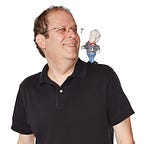Danny Hillis On How to Think Long Term (And Still Stay in Business)
It’s trendy for companies to say they’re thinking long term. Unfortunately, for many businesses “long term” equates to “next quarter’s earnings.” And then there’s Danny Hillis.
Hillis is best-known as an inventor and entrepreneur (he was a pioneer in commercial parallel supercomputers and artificial intelligence). He’s co-chairman of Applied Minds, a research and development company that led to entities like Metaweb (a semantic web innovator) and Applied Proteomics (developed a new way of measuring protein in blood). Previously, among many other things, Hillis was an executive for Walt Disney Imagineering and founded the MIT spinoff Thinking Machines. In his free time, he’s done things like build a computer out of Tinkertoys.
For the past 20-odd years, a long time in the technology market but a blip in the timeframe he likes to ponder, Hillis has served as a co-chairman of The Long Now Foundation, a NewCo focused on promoting long-term thinking. Its most high-profile project is The 10,000 Year Clock, which Hillis designed as “a large (think Stonehenge) mechanical clock, powered by seasonal temperature changes. It ticks once a year, bongs once a century, and the cuckoo comes out every millennium.”
I spoke to Hillis about how organizations can last, perhaps even as long as the clock he’s building. This interview is edited down from two lengthy conversations.
How important is adapting to change when it comes to building companies that last?
It’s crucial. Shell Oil started out as a company that imported and exported lamps made out of shells. Their market was limited by the whale oil that they sold for their lamps. As a result, they started importing petroleum so they wouldn’t have to be limited by whale oil anymore. The rest is history.
Often you have companies that reinvent themselves a few times. IBM is still here because it changed from being the company that made typewriters to something else. It went through a sequence of things in between typewriters and what it is now.
When IBM was in the typewriter business, they could never have known that it’d one day be managing cloud infrastructure.
Exactly. Longevity is not so much having a long‑term plan and sticking to it. Longevity is actually more about being adaptive, with the big exception being when there’s a company connected to some physical resource, like a mine or forest or a farm. In those cases, the physical resources provide the continuity.
Cities are not really companies, but they’re much longer‑lived than companies, because there’s a big physical resource there. Even if you took all the people out of it, replaced them with other people, there would still be some continuity in a city.
Longevity either comes from having a physical resource that is long‑lived, or by being adaptable and changing what you are.
The Long Now Foundation is explicitly about promoting long-term thinking. How does thinking long-term affect how you hire?
We’re building something that we want to outlast us. Part of supporting that is deliberately hiring inter-generationally. When the average age of our staff is going up, we hire younger people at the bottom to replace them. Eventually, we founders are going to age off. We’re very aware of that. We want generational continuity. That’s an explicit decision that we make. What we’re building is not there for us. It’s there for the long term.
What have you learned about how organizations balance long-term goals with short-term necessities?
If I look at the short-term endeavors of mission‑driven companies, I can definitely see examples where it’s a very successful medium‑term strategy for a company to have a long‑term mission. That’s true even though that long‑term mission actually may change over a century or so. Amazon.com is a good example of a company with a sense of mission. This is part of why [Amazon founder] Jeff Bezos is so supportive of our Clock. You can see it in how he runs his company.
“The mission trumps short‑term decisions.”
Amazon’s very first shareholder report said something like, “Our quarterly earnings aren’t going to mean anything. We’re investing for the long term to build assets, build customer loyalty, solve the problem of customers getting the products they want. That’s going to have its ups and downs if you look at our quarterly earnings. We’re going to lose money for a while. That doesn’t really matter, because we still have this sense of mission.” Jeff rereads that original shareholder letter to the shareholders every year. It’s a long‑term picture of what they’re trying to do. The mission trumps short‑term decisions.
I have to say, and this is by way of confession, that I probably lean too much towards the long term. Any business has to have a balance between the short and long term. The truth of the matter is you’re going to need both of them. It’s great to be visionary, but you also have to keep yourself healthy in order to live out your long‑term plan. You can lose money in a quarter, but you can’t run out of cash.
My company Thinking Machines had a very strong sense of mission. It was making fantastic investments in the future. It had cloud servers before there was a cloud, but it did a really lousy job of managing its short‑term cash and it’s no longer with us. There’s a danger of going too far. I don’t think long‑term is better than short‑term. I do think you have to strike a balance, where you’re paying enough to the short term that you’re staying healthy, and you’re keeping your ability to move and fight in the next battle. It’s not quite as pure a message, but you’ve got to do both.
